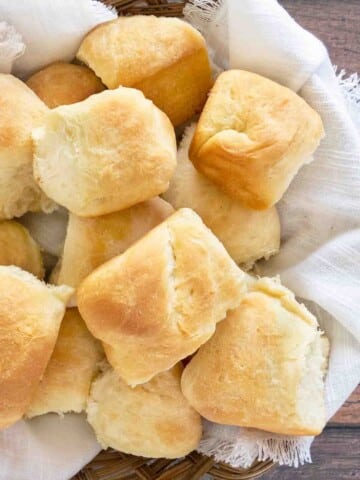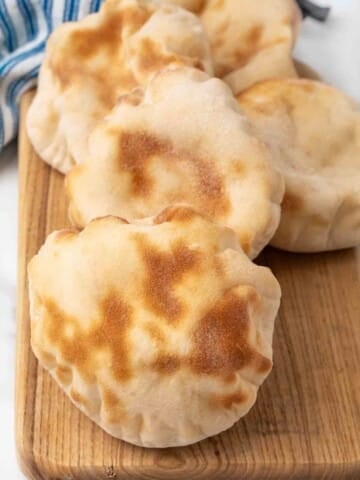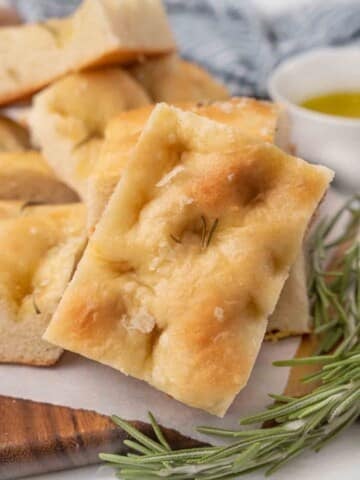What could be better than soft and buttery Parker House dinner rolls warm out of the oven? Perfectly soft and pillowy, so they pull apart into little bites of joy.

Parker House rolls are the perfect roll to complement a weeknight dinner, Sunday supper, or fancy dinner party. There’s something magical about homemade Parker House rolls. Just watch everyone’s eyes light up when you bring them to the table.

Buttery, soft goodness is what makes Parker House rolls so special. Butter is added to the dough during the shaping process. And then even more is brushed on them when they come out of the oven.
If you love homemade dinner rolls, make sure to try our Hawaiian dinner roll and classic dinner roll recipes.
Where Did Parker House Rolls Originate?
They originated at the Parker House Hotel in Boston circa 1870 when a German baker named Ward came up with the recipe for soft crustless rolls. Prior to this recipe, all rolls were hard on the outside, making this unique in texture and flavor.
The rolls became even more popular after Franklin and Eleanor Roosevelt requested the recipe, which was later published in the White House Cookbook.
Ingredients to Make Parker House Rolls

Start by gathering the ingredients needed to make our Traditional Parker House Rolls recipe. In culinary terms, this is called the Mise en Place, which translates into “Everything in its Place.”
Setting up your ingredients not only helps speed up the cooking process but also helps ensure you have all of the ingredients on hand to make the recipe.
What type of flour is best?
I use King Arthur flour for all my baking needs.
How to Make Parker House Rolls

- Add the whole milk to a small saucepan and heat to 110 degrees F.
If the milk is too hot, it will kill the yeast. - Add the warm milk, active dry yeast, and two tablespoons of granulated sugar to the bowl of a stand mixer fitted with the paddle attachment. Mix to combine, then let it sit for about 5 minutes until it gets foamy and the yeast activates.
- Add 2 ½ cups of flour, unsalted butter, two tablespoons of sugar, large egg and large egg yolk to the milk mixture.
- Set the mixer to the lowest speed and mix until the ingredients are combined.
Scrape the bottom and sides of the bowl as needed. - Increase the speed to medium-low and continue to mix for 2 minutes.
*Change the paddle to the dough hook attachment.

- Add ½ cup of all-purpose flour to the bowl at the lowest speed, increasing to medium-low when the flour is mostly incorporated. Continue mixing for 2 minutes.
- And another ½ cup of flour, mixing at low speed until the flour is incorporated. Increase to medium speed and continue mixing for 2 minutes until a ball of dough forms. Add additional flour, if necessary, two tablespoons at a time until the right consistency is achieved.
The dough should be sticky and soft and pulling away from the sides of the bowl, but still sticking a little to the bottom of the bowl. The rule of thumb with bread and rolls is to add the least amount of flour possible that allows you to work with the dough. - Transfer dough to a lightly oiled bowl and cover with a clean kitchen towel or plastic wrap. Place the bowl in a warm draft-free area of the kitchen and let the dough rise until doubled in size (60 to 90 minutes).
- Remove the towel or plastic wrap and punch the dough down gently.
The dough can be made a day in advance and refrigerated. The first rise will come while it’s refrigerated. The second rise must be at room temperature.

- Divide the dough into two pieces and transfer to a very lightly floured work surface. Then, roll the dough into a rectangle measuring approximately 8” x 12”.
Don’t add too much flour; remember to use the least possible amount of flour. - Brush the surface of the dough with two tablespoons of the softened butter, making a light, even coating.
- Cut the dough in half lengthwise so you have two 4″ x 12″ rectangles.
- Fold one piece of dough lengthwise so it almost meets the other edge. About ½ inch of the other edge should be showing. The rectangle should now be roughly 2 ¼″ x 12″.
- Repeat with the other piece of dough.
- Cut each of the rectangles in half and then in half again so you have four 3″ pieces. Repeat the process with the other rectangle to make a total of eight equal pieces.
- Turn them over and place them with the folded side down in a lightly greased 9 x 13-inch baking dish.
- Place the rolls in the dish so there are four in a row, with the longer sides matching the longer side of the baking dish.
- Repeat the entire process with the second half of the dough. There should be 16 rolls in the baking dish.
*Don’t roll the dough to make perfect little dough balls. Parker House rolls are supposed to have a (pocketbook) foldover shape.
Preheat the oven to 350°F.

- For the second rise, cover the baking dish with plastic wrap or a clean kitchen towel. Let the rolls rise until almost doubled in size (45 – 60 minutes) and are nice and puffy.
- Place the baking dish on the center rack of the preheated oven and bake for 20 to 25 minutes until they’re golden brown.
- Remove the pan from the oven, and brush with the remaining softened butter (you can use melted butter if you prefer).
- Pull the baked rolls apart to serve.

The signature “fold” of Parker House rolls is what sets them apart from other dinner rolls. They’re so much fun to split, knowing you can add even more butter to the roll!
Store leftover dinner rolls in an airtight container for 1-2 days at room temperature or 2-3 days refrigerated. They are best when served the day baked. If refrigerated or to refresh, warm the rolls for 4-5 minutes in a 350-degree oven.
They can be stored in a freezer-safe container for up to two months. Thaw and reheat the dinner rolls in a 350-degree oven for 4-5 minutes before serving.
Recipe FAQ’s
Too much flour can cause them not to rise sufficiently. Make sure to just use enough flour to keep the dough from being sticky, but not so much that the dough is too stiff.
The other reason could be that the yeast is old or that the milk was too hot and killed the yeast. It’s important to check the date on the yeast and use an instant-read thermometer to make sure the milk is not above 110 degrees F.
It’s the butter. Brushing softened butter on the dough before folding and the added butter after baking gives them that extra special buttery flavor that everyone loves. The folded pocketbook shape also makes them pull apart easily.
The dough was not kneaded long enough to activate the gluten. The dough has to be kneaded long enough for it to be soft and stretchy. This is what creates the light and fluffy texture.









Leave a Comment